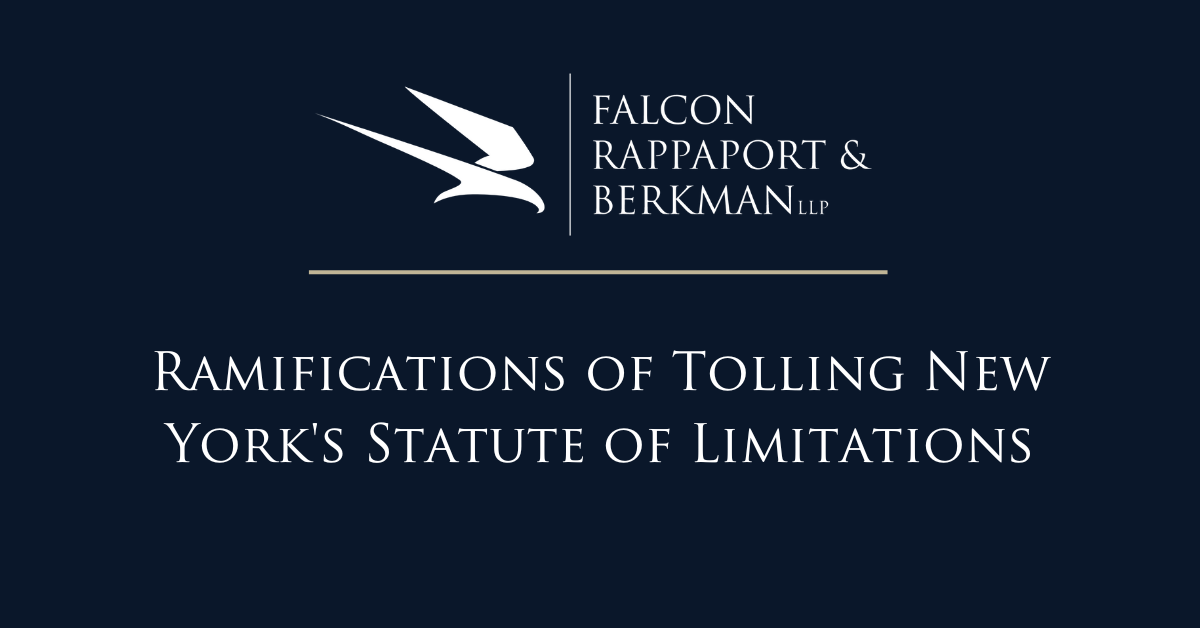Ramifications of Tolling New York’s Statute of Limitations
Ramifications of Tolling New York’s Statute of Limitations
By: Kenneth J. Falcon, Esq. and Stephen Rutman
On March 20, 2020, amidst the initial tumult of the COVID-19 pandemic, Governor Andrew Cuomo issued Executive Order 202.8, which, among other things, tolled New York’s statute of limitations through April 19, 2020. This order directed that “any specific time limit for the commencement, filing, or service of any legal action, notice, motion, or other process or proceeding” would be “tolled from [March 20, 2020] until April 19, 2020.”
The Governor has subsequently issued three successive extensions, which—barring certain limited exceptions—further tolled the statute of limitations in New York until July 6, 2020. It is conceivable that, depending upon the state of the pandemic, Governor Cuomo could extend the provisions of Executive Order 202.8 even further into the future.
Although the Governor’s decision to adjust the statute of limitation in light of the extraordinary circumstances did not stimulate substantial controversy at the time of execution, more recently, the finer details and longer-term impacts of the Governor’s orders have prompted scrutiny.
Comparison to Previous Executive Orders
The decision to issue executive orders affecting the statute of limitations in New York is not without precedent. In the aftermath of the September 11, 2001 terrorist attacks and in the wake of Hurricane Sandy, Governors Pataki and Cuomo, respectively, took similar actions.
The recent executive order in response to COVID-19 differs from those implemented in past emergencies. The prior orders “temporarily suspended” the operation of statutes of limitations for actions “whose limitation period conclude[ed] during the period commencing from the date that the disaster emergency was declared” until such orders were lifted. See Executive Order No. 113.7 of Governor Pataki and Executive Order No. 52 of Governor Cuomo. These filing extensions therefore applied only to those claims with limitations periods due to expire during the temporary suspension periods.
By contrast, the language of Executive Order 202.8 expressly tolls the limitations periods, rather than suspending them. With respect to statutes of limitations, Black’s Law Dictionary defines “toll” as “to stop the running of; to abate.” Toll, Black’s Law Dictionary (11th ed. 2019). Accordingly, claims with limitations periods not due to expire between March 20, 2020 and the end-date for Executive Order 202.8 (currently July 6, 2020) will likely also have their limitations clocks stopped for the duration of time that the Order’s provision remain in force (currently 108 days). Whether deliberate or inadvertent, the language of Governor Cuomo’s recent executive order applies to a far broader set of potential claims than did similar executive orders in New York’s recent history.
Courts interpreted the previous executive orders in connection with September 11th and Hurricane Sandy specifically as “grace periods” rather than “blanket tolls.” In Scheja v. Sosa, for instance, the Second Department held that the post-September 11th executive orders provided plaintiffs “whose statute of limitations period expired between September 11, 2001 and November 8, 2001 . . . a grace period of up until November 8, 2001, to satisfy the statute.” 4 A.D.3d 410, 411-412 (2d Dep’t. 2004). The court rejected the argument that the executive order applied to litigants with limitations periods expiring outside of that narrow range, such as the plaintiff, who was required to commence his action by February 2002, well after the November 8, 2001 lifting of the temporary suspension, but filed in March 2002. Id at 412. Likewise, following Hurricane Sandy, courts interpreted Governor Cuomo’s executive order as suspending, rather than tolling the statutes of limitations. See Williams v. MTA Bus Co., 44 Misc. 3d 673, 684-85 (Sup. Ct., N.Y. Cty. 2014) (holding that the temporary suspension from October 26, 2012 through December 25, 2012 did not apply to an action with a limitations period expiring in August 2013).
Long-Term Implications
If Executive Order 202.8 is interpreted in the broad manner described above, it will affect litigants’ calculations of statutes of limitations far into the future. These calculations will be more complex than those necessitated by past executive orders. Instead of considering a single end-date to determine whether an extension applies, any claim with a limitation period that overlaps with the effective duration of Executive Order 202.8 and its extensions will require an individual calculation.
Future litigants may challenge the Executive Order as beyond the scope of the Governor’s emergency authority derived from Section 29-a of the Executive Law. Especially in cases where the expiration of the limitations period is quite distant, litigants might argue that the toll order was not “necessary to cope with the disaster” or “reasonably necessary to aid the disaster effort,” as required by the statute.
The unprecedented language of the Governor’s Executive Order has raised questions about whether the toll might be further altered—or potentially even curtailed—by a subsequent order after the emergency has subsided. Regardless, this issue is likely to persist far beyond the immediate COVID-19 crisis, until definitive appellate court guidance is issued.
Conclusion
If you have any questions about the above, please contact Kenneth J. Falcon at kfalcon@frblaw.com or (212) 203 – 3255.
DISCLAIMER: This summary is not legal advice and does not create any attorney-client relationship. This summary does not provide a definitive legal opinion for any factual situation. Before the firm can provide legal advice or opinion to any person or entity, the specific facts at issue must be reviewed by the firm. Before an attorney-client relationship is formed, the firm must have a signed engagement letter with a client setting forth the Firm’s scope and terms of representation. The information contained herein is based upon the law at the time of publication.

